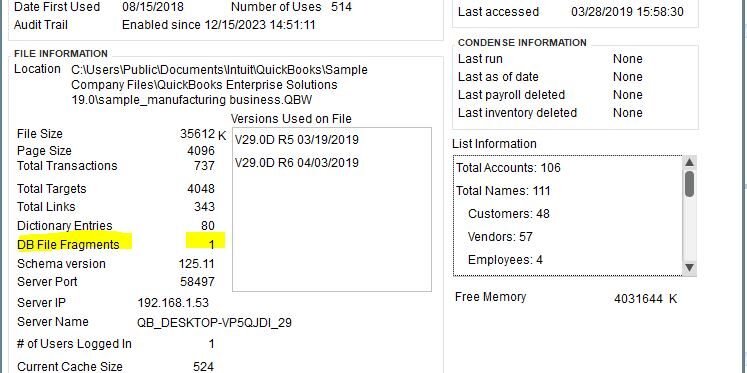Data File Fragments and How to Fix Them
Revised 09-08-2020. Previously posted 2015, revised 04-22-2019
This is a re-do of a post I originally composed in 2015 about Data File Fragments. New since then – Solid State Drives. If you have an SSD, please don’t attempt a de-frag. Most likely, you will not experience these problems from a performance standpoint because of the way SSDs are built/function. If you have a SSD and are experiencing file issues, let us know.
As a diligent QuickBooks Desktop user, some file maintenance is required. We make our regular backups via the automatic backup utility, plug along, and one day, poof! Our file is giving us fits, crashing, and just generally acting like a three year old two hours late for a nap. Not fun.
Before thinking all is lost, check your file fragments. It’s easy to do, and can give you an eagle’s eye view into your QuickBooks file in the process.
To check out your file frags, hit F2. It will bring up our ever trusty dialogue box. In the photo below, you can see that this file has 12 data file fragments (seriously? That’s awesome!).
As you can imagine, the more fragments you have the more of a maintenance issue you have. The lower the number the better it is. The magic number is under 20, but if you are over this then it isn’t the end of the world. You are just in the yellow zone. The fewer fragments you have the quicker that the file can be read. File fragments in and of themselves are not the problem – you will never have 0 fragments. They are just one of the gauges to measure file health (highest I’ve seen was over 300, and that was a rough one!).
If you have less than 100 fragments you most likely won’t run into too many performance issues. This isn’t to say you won’t, just to say you probably won’t. Just as I don’t always agree with the message from QuickBooks Support, this is an area in which I will say that the message is to stay under 100, but Katie says to try to stay under 20/30. Improving your hardware will help keep disk fragmentation from happening, and if you follow an archive process for your data files, that will help a lot as well.
My recommendation to clients is generally to keep no more than 4-5 years of history in a file unless you are a small business. Make an archive copy of your file and use the condense utilities to start a new one. If you have trouble with this process, let us know.
The more fragments, the more running around QuickBooks is doing to try to pull in all of the information needed to read your file. Similar to Windows, every once in a while the equivalent of a defrag is needed.
Some of the troubleshooting steps to fix this error are below:
Save a portable copy of the file, and restore it. This removes some temporary files and does a quick and light condense of your file.
De-frag the drive your file is on from Windows. Bonus points – your whole drive gets de-fragmented!
Do a condense of your file. The smaller the file the less likely your computer will have to save fragments in different areas.
Once you have your issues under control, I highly recommend ensuring that your hardware meets the Minimum Specs (hopefully more), and that you have plenty of space for your file to be saved as it grows.
If you have trouble with these steps, or would like to discuss then you can take appropriate action below. Thank you so much for reading! Please feel free to leave a comment if you are so inclined! :-)


